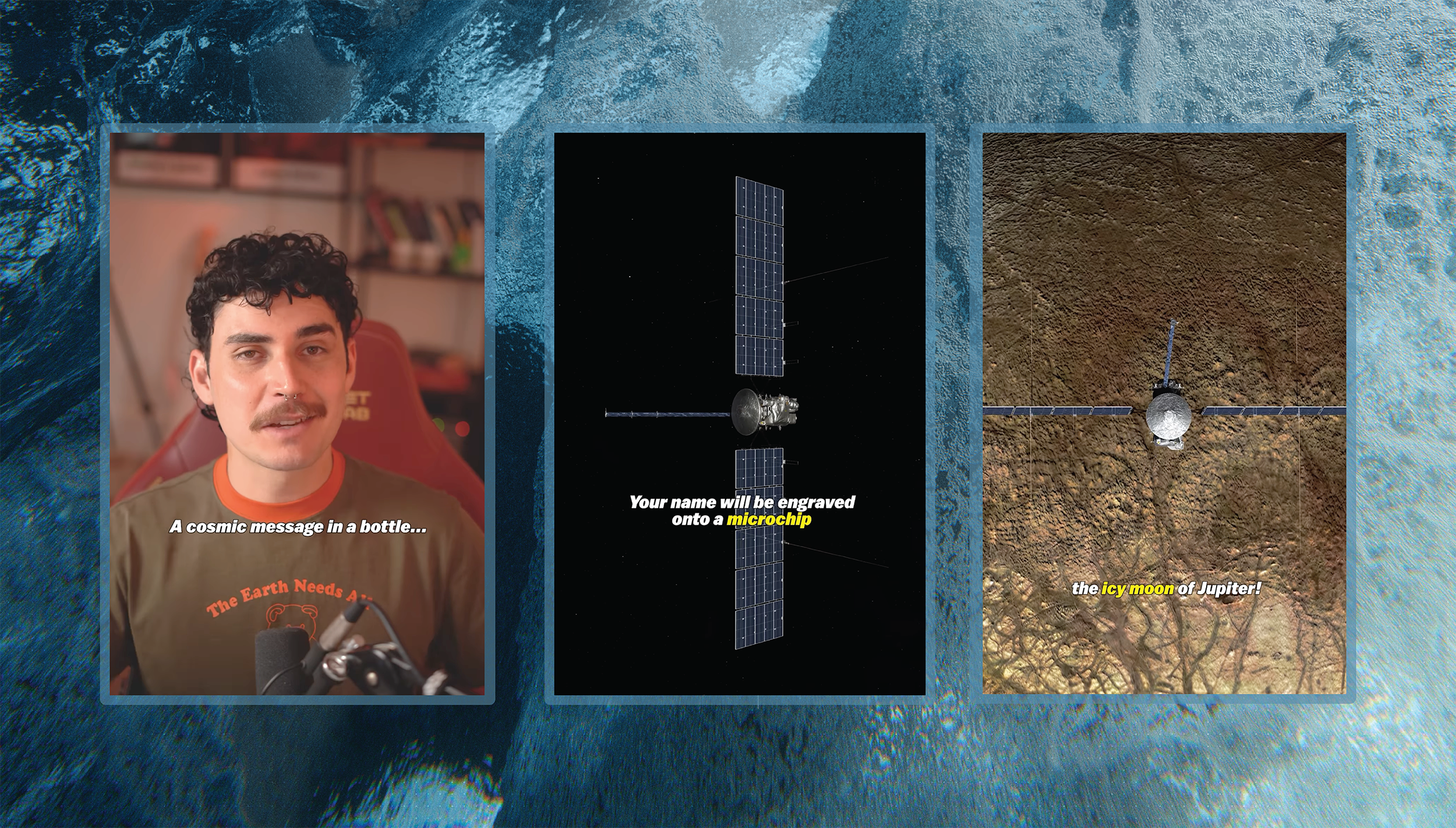Flying Your Name to Jupiter on NASA's Icy Moon Explorer
Over 2.6 million people around the world joined NASA’s Message in a Bottle campaign, a first-of-its-kind initiative that invited people to sign their names to a special message traveling 1.8 billion miles on the agency’s Europa Clipper spacecraft. Launching in October 2024, Europa Clipper will explore Jupiter’s ocean moon Europa, which is considered one of the most promising currently habitable environments in our solar system. The message, a poem written by U.S. Poet Laureate Ada Limón, is engraved on the robotic spacecraft. Participant names will journey alongside the poem.
The campaign enhanced public involvement in NASA science and showcased the role of art in exploration—and sparked the imagination of people around the world.
Campaign OverviewCampaign Overview
It’s not every day that members of the public have the chance to send their names into deep space beyond Mars, all the way to Jupiter and its moon Europa. But with NASA’s Europa Clipper, NASA gave the public that opportunity: Names are etched on a microchip that will be affixed to the spacecraft as it journeys 1.8 billion miles (2.6 billion kilometers) to this icy moon, where an ocean hides beneath a frozen outer shell.
Over 2.6 million people around the world joined NASA's Message in a Bottle campaign—setting a new record for the most names ever flown on a spacecraft beyond Mars.

The chip will be attached to a metal plate engraved with the original poem “In Praise of Mystery: A Poem for Europa,” written by U.S. Poet Laureate Ada Limón to celebrate the mission. Riding on the exterior of the spacecraft, the poem and names will be like a message in a bottle as they make about 50 close to flybys of the ocean world. The mission will gather data to determine if Europa could support life.
The campaign inspired people around the world. Between June and December 2023, NASA collected over 2.6 million names to send to the Jupiter system. By coming aboard, participants get the chance to be part of history as NASA looks to answer some of humanity’s biggest questions: How does the universe work, and are we alone?
Read the poem and view the campaign website ›
NASA Partners with U.S. Poet LaureateNASA Partners with U.S. Poet Laureate Ada Limón
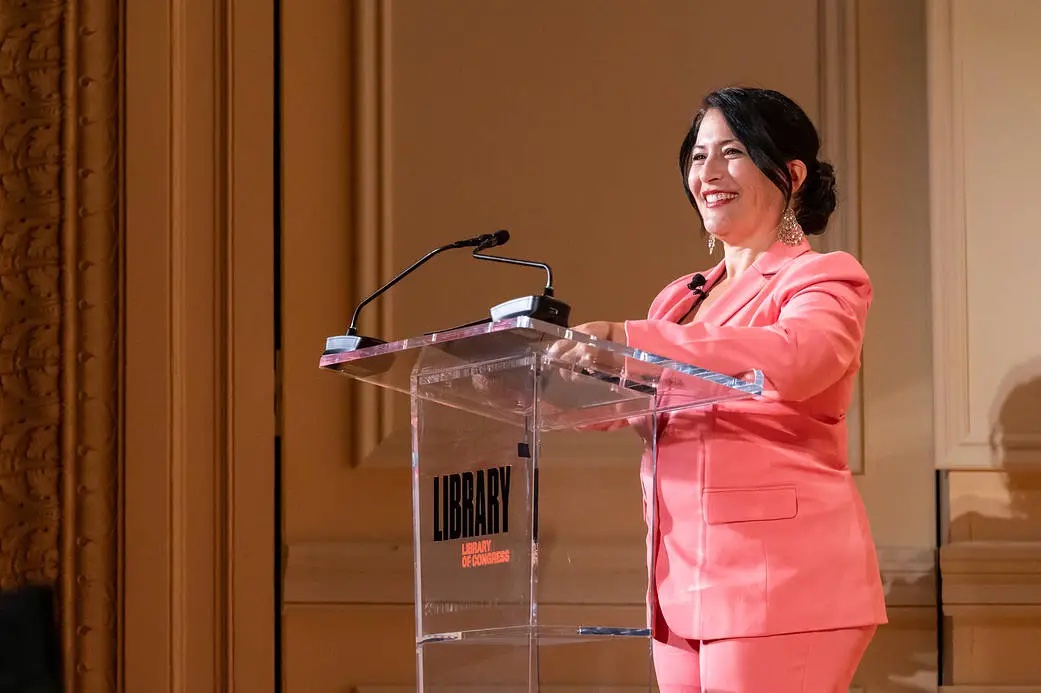
The campaign is a first-of-its-kind collaboration, uniting art and science, by NASA, the U.S. Poet Laureate, and the Library of Congress. Participants aren’t just having their names flown on a spacecraft—they’re signing their names to a poem written by U.S. Poet Laureate Ada Limón. The poem connects the two water worlds — Earth, yearning to reach out and understand what makes a world habitable, and Europa, waiting with secrets yet to be explored.
The poem was revealed at a public event hosted at the Library of Congress on June 1, 2023. The event was steamed live by the Library of Congress, on NASA TV, and carried on PBS and space.com.
Learn more about the parntership ›
A Legacy of InspirationA Legacy of Inspiration
The campaign is similar to other NASA projects that have enabled tens of millions of people to send their names to ride along with Artemis I and several Mars spacecraft. It draws from the agency’s long tradition of shipping inspirational messages on spacecraft that have explored our solar system and beyond. In the vein of NASA’s Voyagers’ Golden Record, which sent a time capsule of sounds and images to communicate the diversity of life and culture on Earth, the program aims to spark the imagination of people around the world.
How Names Are Etched on the Microchip
Technicians in the Microdevices Laboratory at NASA’s Jet Propulsion Laboratory in Southern California use an electron beam to stencil participant's names onto a dime-size silicon microchip. Each line of text is smaller than 1/1000th the width of a human hair (75 nanometers). The public engagement team produced a behind-the-scenes tour of the lab where the microchip is produced, showing participants how it works.
Innovative WebsiteInnovative Website
We built a dedicated microsite for the campaign that allowed users to dive through Europa’s ice, read the poem by U.S. Poet Laureate Ada Limón, and sign up for the campaign. Upon signing up, users were presented with a social media shareable graphic customized with their name. Users could download, print, or share the graphic on their social networks, using native share trays on mobile devices.
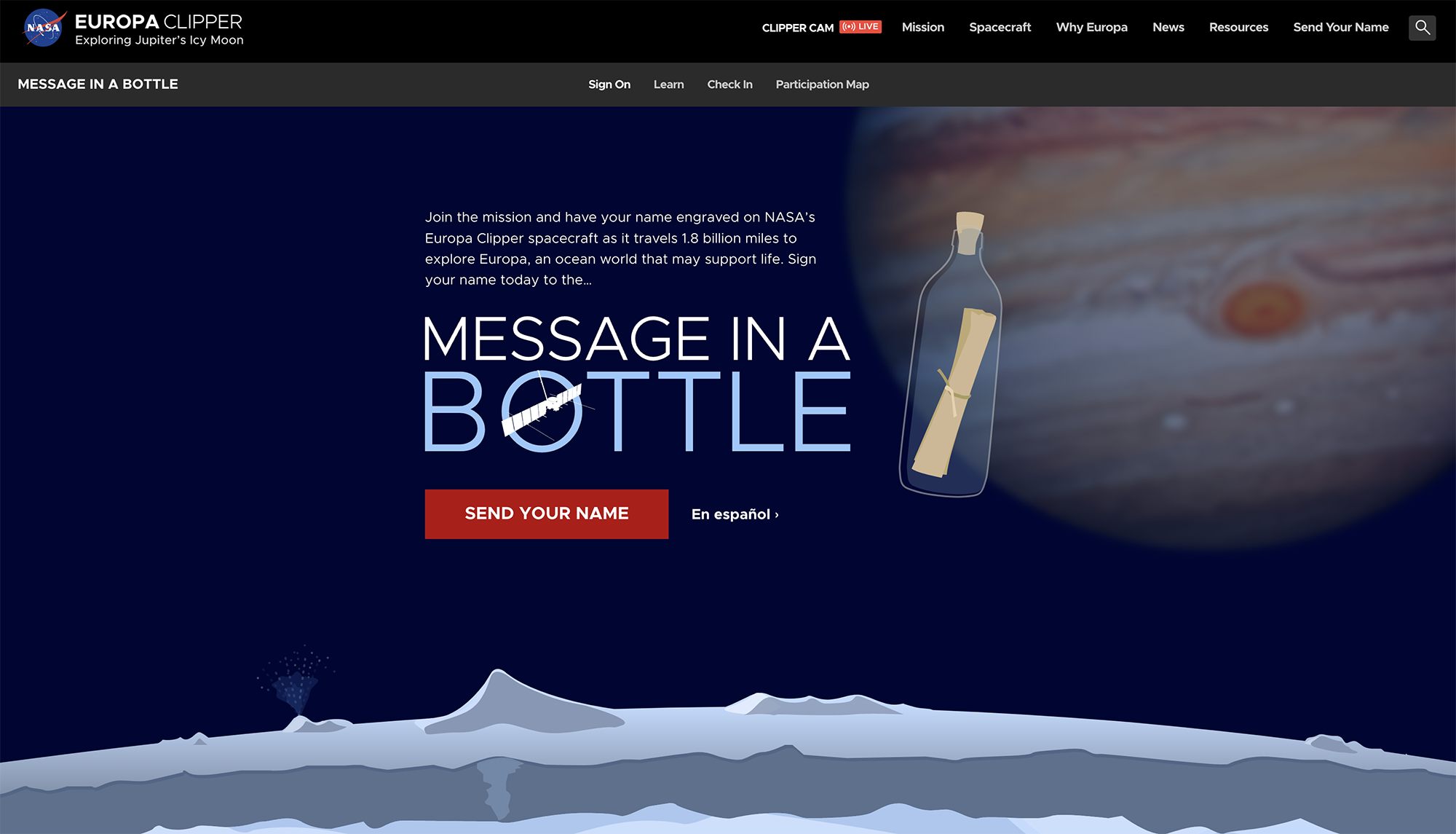


Global ParticipationGlobal Participation
Space exploration transcends borders. Our global outreach efforts resulted in participation around the world. Coupled with our media and social outreach, we worked with partner organizations to help spread the word, including NASA’s Solar System Ambassadors and the Girl Scouts of USA.
View the campaign's global heat map ›
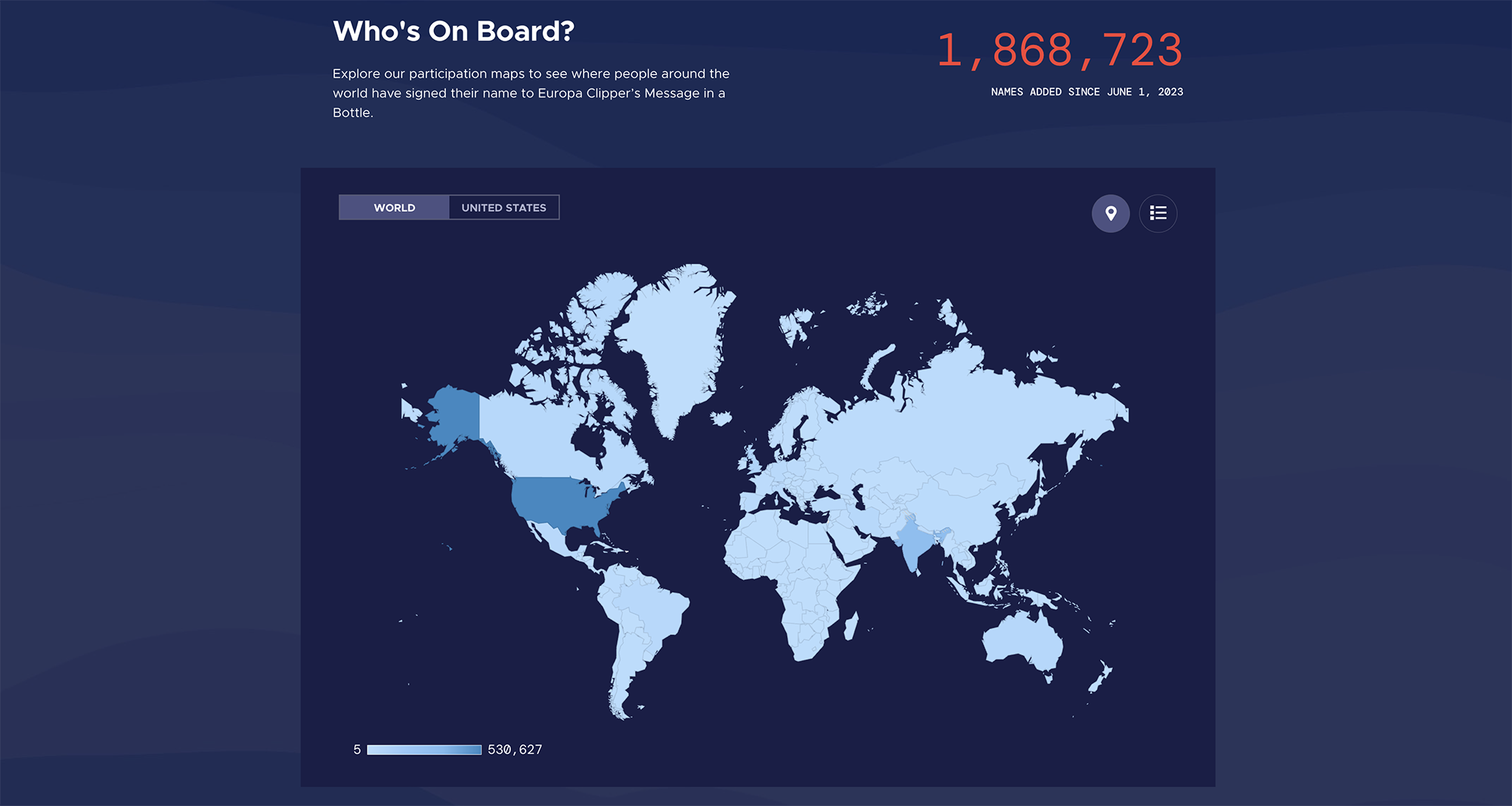
Social MediaSocial Media
Our social media campaign ignited imaginations worldwide. We leveraged NASA’s full social media reach to raise awareness of the campaign on a global scale. Participants received social shareables, customized with their names, that they can show off to friends and family. We welcomed our Sesame Street friends and Snoopy on board, along science communicators and other spacecraft. Meanwhile, a social countdown campaign started several weeks from the deadline, using shareables to tell the public how much time they have left to sign on.
Activating NASA’s Social Channels
The campaign was promoted by over 50 NASA social media accounts, linking to related NASA science and the agency's legacy of exploration. Select posts below show how the campaign was integrated across NASA missions and accounts.
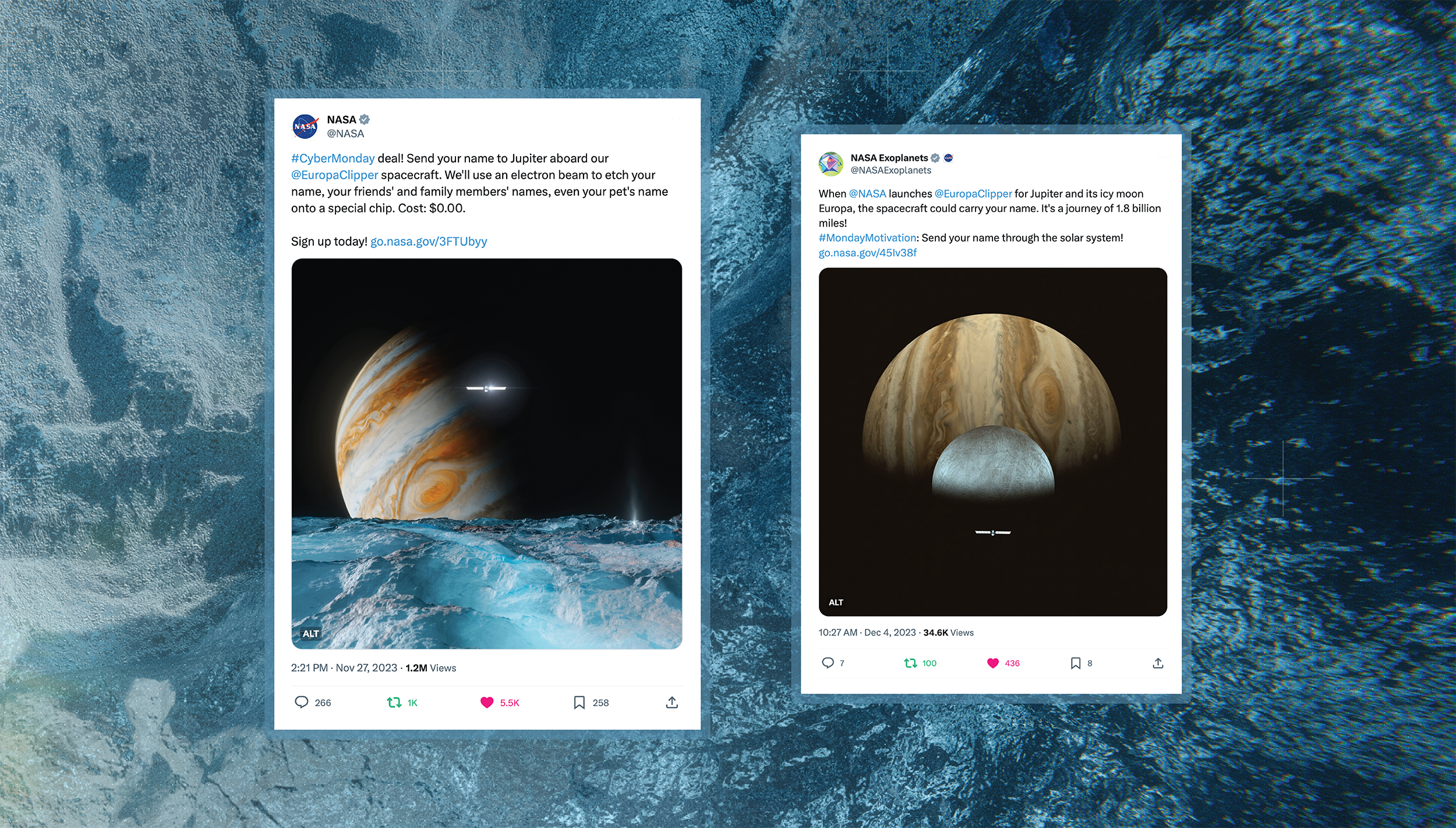
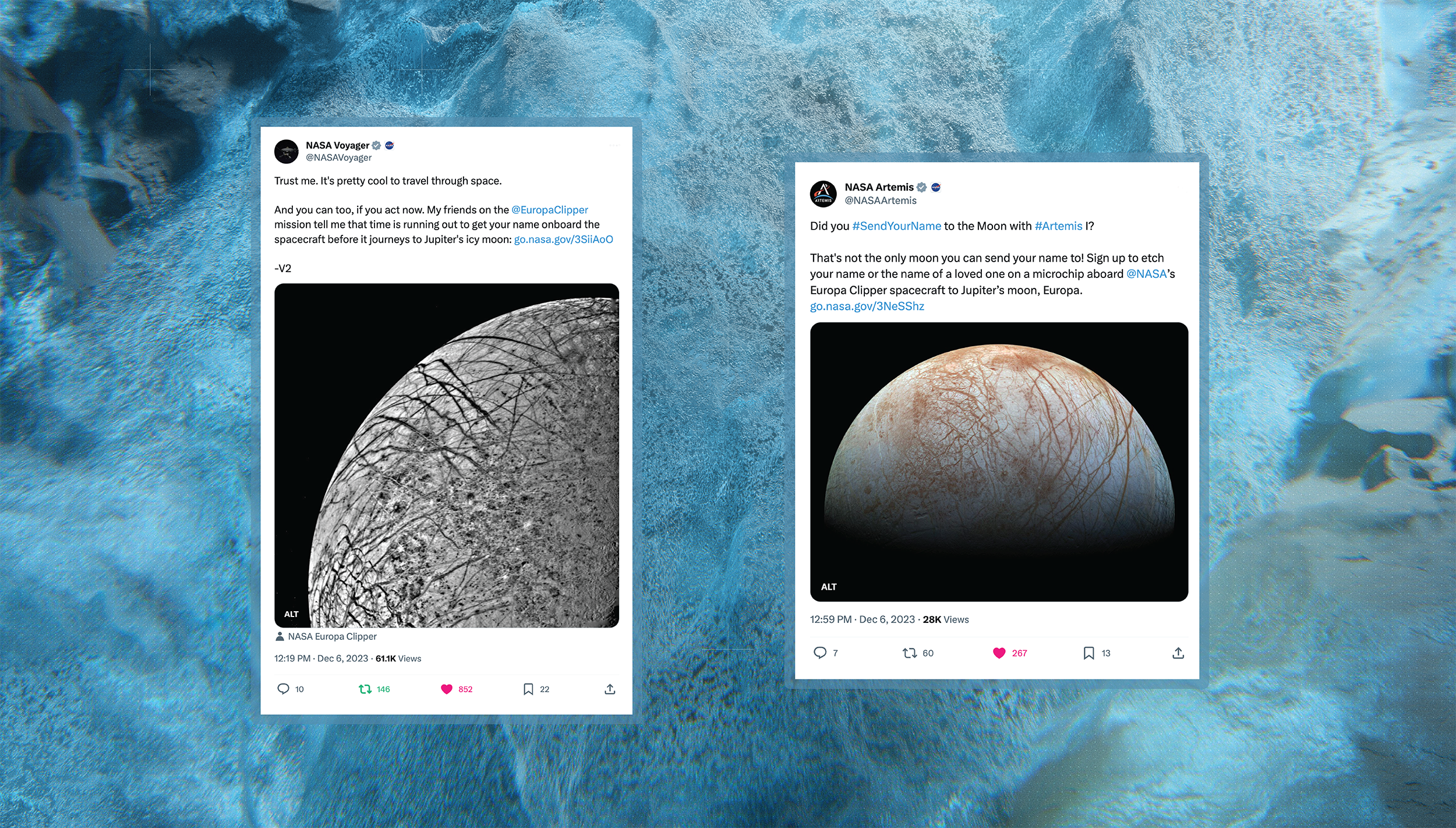
High-Flying Friends
NASA partnered with Sesame Street and Snoopy to promote the campaign with three dedicated social collaborations. Sesame Street released custom artwork featuring Elmo holding a bottle in space, and characters engaged with various NASA accounts. In addition, Sesame Street dedicated the "Letter of the Day" to be "M for moon". Snoopy content included a clip from the Apple TV "Snoopy in Space" cartoon show, where Snoopy goes to Europa. Even Lance Bass stopped by NASA's Jet Propulsion Laboratory to promote the campaign.
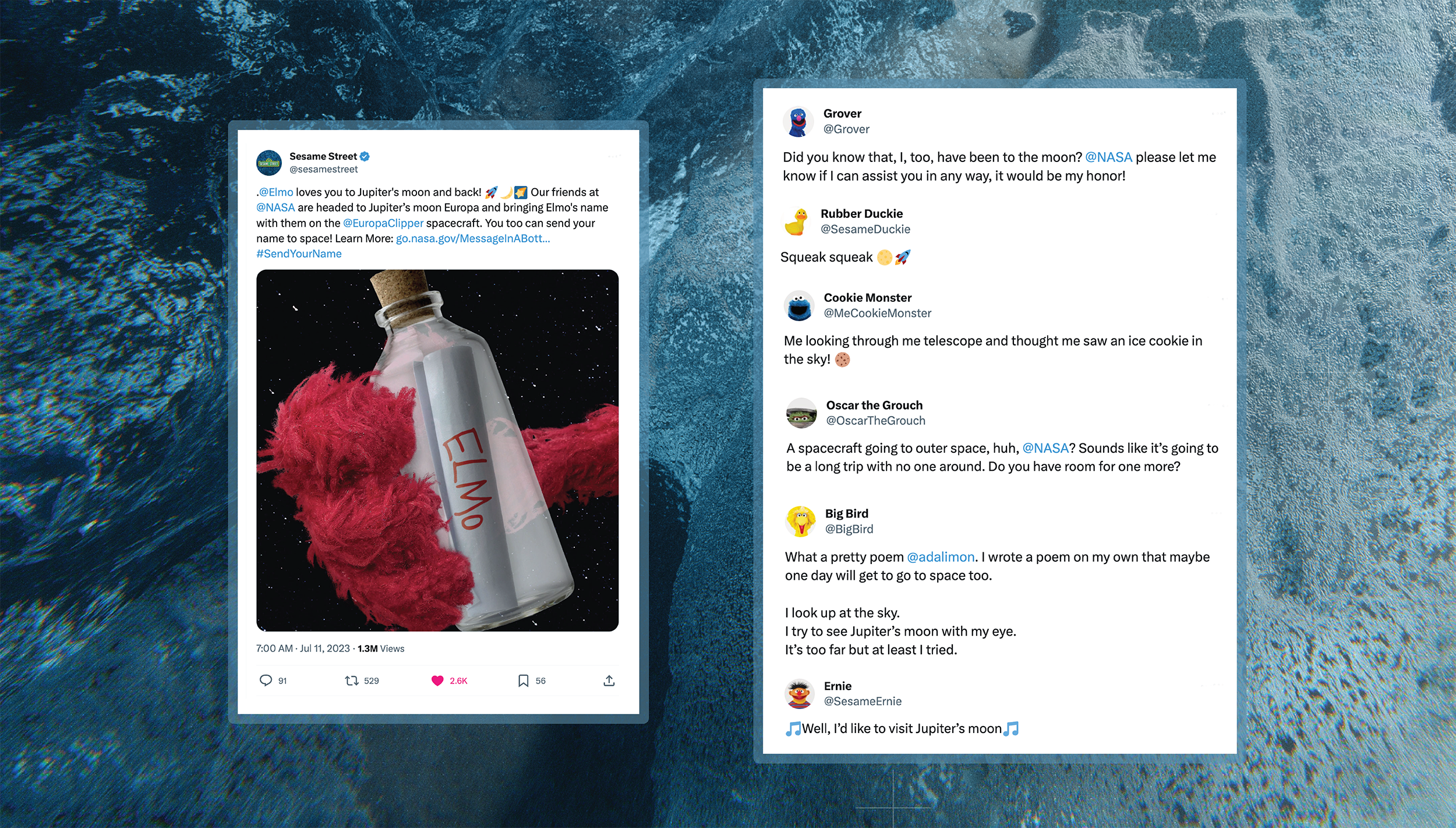

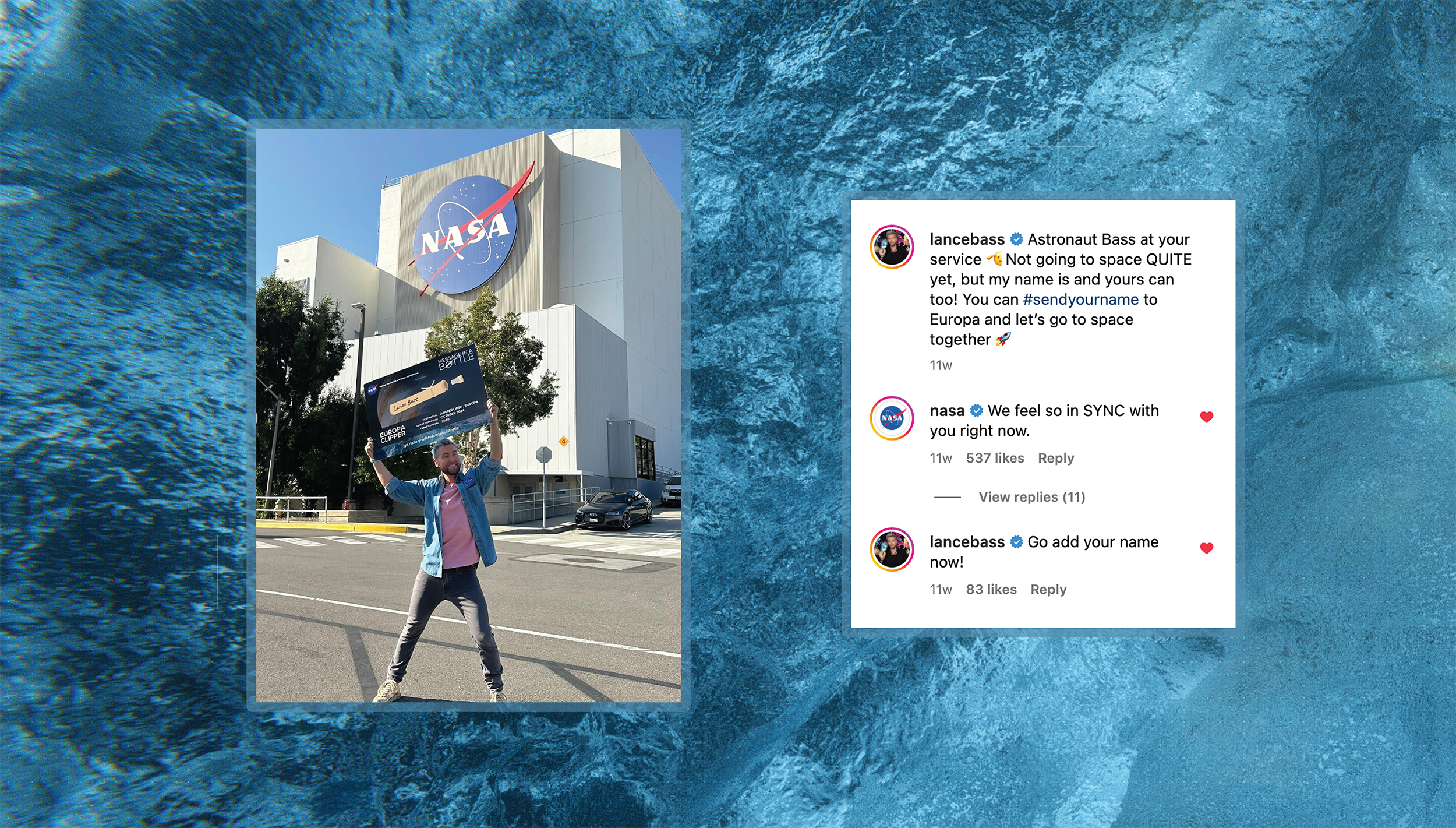
Fellow Missions
NASA spacecraft including Peseverance and Curiosity signed on, along with the European Space Agency's Juice spacecraft.
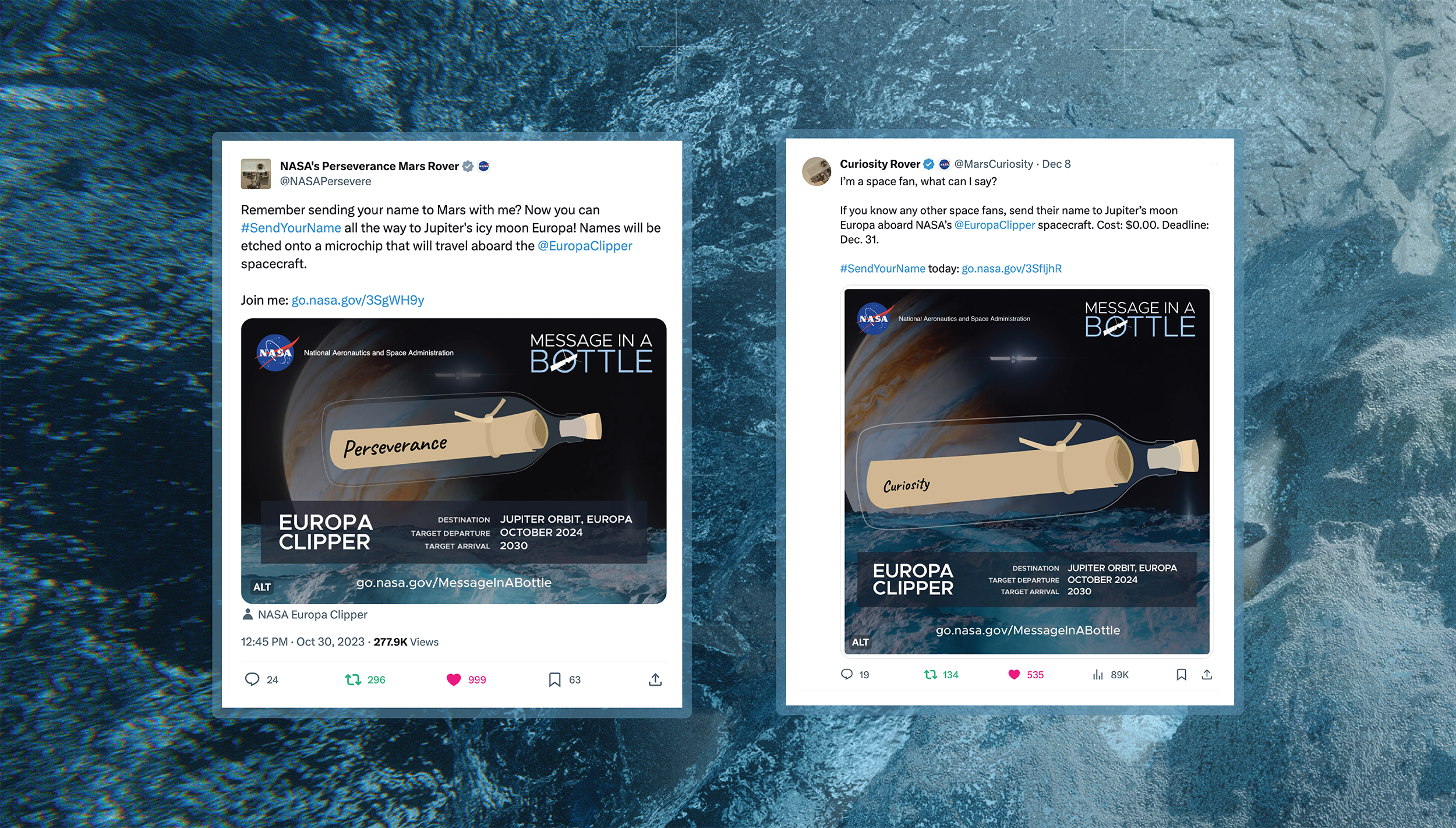
Content Creators
Content creators organically promoted the campaign across their channels. One video, produced by Kobi Brown, recieved over 5 million views.
Twitch
The campaign was promoted as part of a live stream on the NASA Twitch account, giving viewers a behind-the-scenes look at the Europa Clipper spacecraft while it was being assembled in a cleanroom at NASA's Jet Propulsion Laboratory.
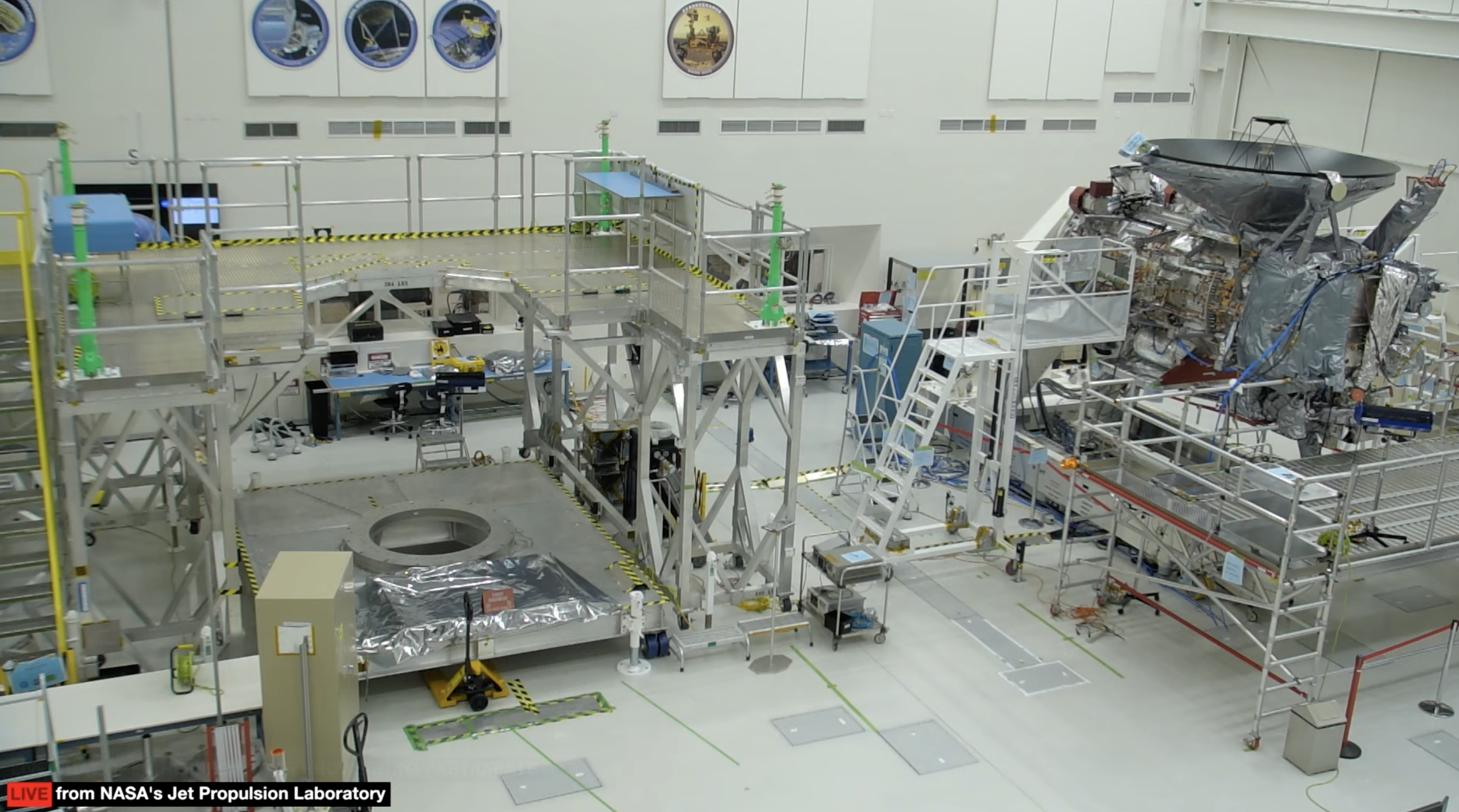
SpanishSpanish
We created a dedicated Spanish microsite for the campaign. Translating poetry is tricky, but we teamed up with Puerto Rican poet Roque Raquel Salas Rivera to bring Ada Limón's poem to life in Spanish. The campaign was promoted across NASA en español social media accounts on NASA Ciencia.
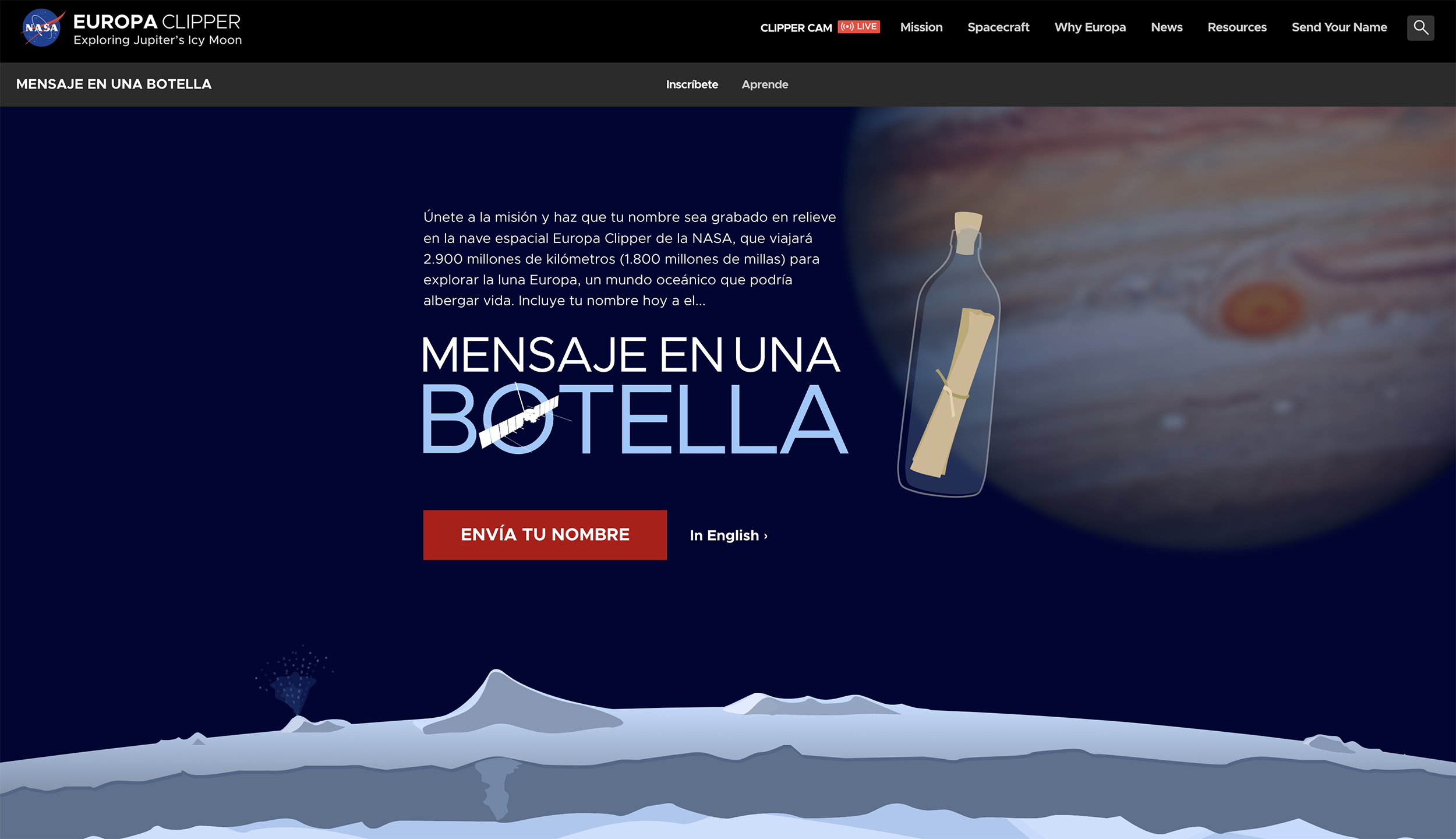
Global Media CoverageGlobal Media Coverage
This mission has made hundreds of headlines in over 10 languages worldwide. From AP News to NPR, space.com to the Smithsonian Magazine, the Literary Hub to the Washington Post, everyone has been talking about this journey to Jupiter. We even got meteorologists involved, encouraging people to gaze up at Jupiter and join our mission.

Vault Plate RevealRevealing the Vault Plate
During the SXSW 2024 Opening Session, NASA's Planetary Science Division Director Dr. Lori Glaze and U.S. Poet Laureate Ada Limón revealed the design for the commemorative vault plate that will carry participant names. At the heart of the triangular metal plate is the engraving of U.S. Poet Laureate Ada Limón’s handwritten “In Praise of Mystery: A Poem for Europa,” along with the silicon microchip stenciled with more than 2.6 million names submitted by the public. The microchip will be the centerpiece of an illustration of a bottle amid the Jovian system – a reference to NASA’s “Message in a Bottle” campaign, which invited the public to send their names with the spacecraft.
Made of the metal tantalum and about 7 by 11 inches (18 by 28 centimeters), the plate features graphic elements on both sides. The outward-facing panel features art that highlights Earth’s connection to Europa. Linguists collected recordings of the word “water” spoken in 103 languages, from families of languages around the world. The audio files were converted into waveforms (visual representations of sound waves) and etched into the plate. The waveforms radiate out from a symbol representing the American Sign Language sign for “water.”


